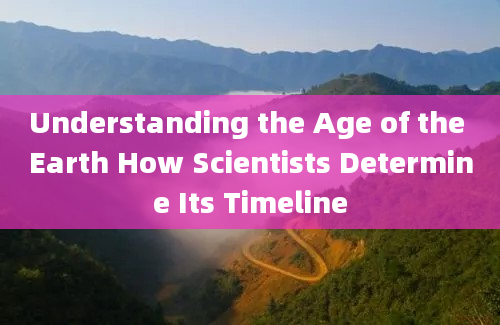Understanding the Age of the Earth: How Scientists Determine Its Timeline

The age of the Earth has been a subject of scientific inquiry for centuries. Through a combination of geological, radiometric, and astronomical methods, scientists have been able to determine that our planet is approximately 4.54 billion years old. This conclusion is supported by a wealth of evidence and rigorous scientific methodologies.
Geological Evidence
Geological evidence plays a crucial role in understanding the Earth's age. The principle of superposition, which states that in undisturbed layers of rock, the oldest layers are at the bottom and the youngest are at the top, provides a basic framework for dating geological formations. Additionally, the study of fossils and the stratigraphy of rock layers helps in constructing a relative timeline of Earth's history.
Source: [U.S. Geological Survey (USGS) Geological Time](https://www.usgs.gov/naturalresources/science/geologicaltime)
Radiometric Dating
Radiometric dating is one of the most significant methods used to determine the absolute age of rocks and minerals. This technique relies on the decay of radioactive isotopes, such as uranium238 to lead206, which occurs at a known and constant rate. By measuring the ratio of parent isotopes to daughter isotopes in a sample, scientists can calculate the age of the rock.
Source: [Berkeley Lab Radiometric Dating](https://www2.lbl.gov/abc/wallchart/chapters/03/2.html)
Astronomical Evidence
Astronomical evidence also contributes to our understanding of the Earth's age. The study of the solar system's formation, including the analysis of meteorites and lunar samples, provides additional clues. For instance, the oldest known meteorites are about 4.56 billion years old, which aligns closely with the age of the Earth.
Source: [NASA Age of the Earth](https://solarsystem.nasa.gov/planets/earth/facts/)
The Integration of Methods
The integration of geological, radiometric, and astronomical methods allows scientists to crossverify their findings, leading to a robust and reliable estimate of the Earth's age. This multidisciplinary approach ensures that the age determination is not based on a single line of evidence but rather on a convergence of multiple independent lines of inquiry.
Source: [National Geographic How Old is the Earth?](https://www.nationalgeographic.com/science/article/howoldistheearth)
Frequently Asked Questions (FAQs)
Q1: How do scientists determine the age of the Earth?
A1: Scientists determine the age of the Earth using a combination of geological evidence, radiometric dating, and astronomical data. Geological methods include studying rock layers and fossils, while radiometric dating measures the decay of radioactive isotopes in rocks. Astronomical evidence comes from analyzing meteorites and lunar samples.
Q2: What is radiometric dating?
A2: Radiometric dating is a technique that measures the decay of radioactive isotopes within rocks and minerals to determine their absolute age. By comparing the ratio of parent isotopes to daughter isotopes, scientists can calculate the time that has elapsed since the rock formed.
Q3: Why is the principle of superposition important in geology?
A3: The principle of superposition is important because it states that in undisturbed rock layers, the oldest layers are at the bottom and the youngest are at the top. This principle helps geologists construct a relative timeline of Earth's history.
Q4: How do meteorites help in determining the Earth's age?
A4: Meteorites, which are remnants from the early solar system, provide a reference for the age of the Earth. The oldest known meteorites are about 4.56 billion years old, offering a benchmark that aligns closely with the Earth's age.
Q5: What role do fossils play in understanding the Earth's timeline?
A5: Fossils help in understanding the Earth's timeline by providing evidence of past life and environmental conditions. They are used to date rock layers and understand the sequence of biological evolution.
Q6: How accurate is radiometric dating?
A6: Radiometric dating is highly accurate when properly applied. It relies on wellunderstood physical principles and has been calibrated against other dating methods, such as dendrochronology (treering dating) and historical records.
Q7: Can radiometric dating be used on all types of rocks?
A7: Radiometric dating can be used on igneous and metamorphic rocks, which contain radioactive isotopes. However, it is less effective on sedimentary rocks, which are composed of fragments of other rocks.
Q8: What is the significance of lunar samples in determining the Earth's age?
A8: Lunar samples, brought back by the Apollo missions, provide insights into the early history of the solar system. Their ages, determined through radiometric dating, support the estimate of the Earth's age.
Q9: How do scientists ensure the reliability of their age estimates?
A9: Scientists ensure reliability by using multiple independent methods to crossverify their findings. The convergence of geological, radiometric, and astronomical evidence provides a robust estimate of the Earth's age.
Q10: Why is understanding the Earth's age important?
A10: Understanding the Earth's age is crucial for comprehending its geological history, the evolution of life, and the processes that have shaped our planet. It provides a foundational context for various scientific disciplines, including geology, biology, and astronomy.
By delving into these methods and understanding the intricate processes involved, we gain a deeper appreciation for the vastness of geological time and the remarkable journey of our planet.










